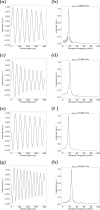Workflow for systematic design of electrochemical in operando NMR cells by matching B 0 and B 1 field simulations with experiments
- PMID: 40539095
- PMCID: PMC12178131
- DOI: 10.5194/mr-5-167-2024
Workflow for systematic design of electrochemical in operando NMR cells by matching B 0 and B 1 field simulations with experiments
Abstract
Combining electrochemistry (EC) and nuclear magnetic resonance (NMR) techniques has evolved from a challenging concept to an adaptable and versatile method for battery and electrolysis research. Continuous advancements in NMR hardware have fostered improved homogeneity of the static magnetic field, , and the radio frequency field, , yet fundamental challenges caused by introducing essential conductive components into the NMR sensitive volume remain. Cell designs in EC-NMR have largely been improved empirically, at times supported by magnetic field simulations. To propel systematic improvements of cell concepts, a workflow for a qualitative and semi-quantitative description of both and distortions is provided in this study. Three-dimensional finite element method (FEM) simulations of both and fields were employed to investigate cell structures with electrodes oriented perpendicular to , which allow realistic EC-NMR measurements for battery and electrolysis applications. Particular attention is paid to field distributions in the immediate vicinity of electrodes, which is of prime interest for electrochemical processes. Using a cell with a small void outside the electrochemical active region, the relevance of design details and bubble formation is demonstrated. Moreover, amplifications in coin cells provide an explanation for unexpectedly high sensitivity in previous EC-NMR studies, implying the potential for selective excitation of spins close to electrode surfaces. The correlation of this amplification effect with coin geometry is described by empirical expressions. The simulations were validated experimentally utilising frequency-encoded 1H profile imaging and chemical shift imaging of 1H, 13C, and 23Na resonances of electrolyte. Finally, the theoretical and experimental results are distilled into design guidelines for EC-NMR cells.
Copyright: © 2024 Michael Schatz et al.
Conflict of interest statement
The contact author has declared that none of the authors has any competing interests.
Figures











Similar articles
-
A rapid and systematic review of the clinical effectiveness and cost-effectiveness of paclitaxel, docetaxel, gemcitabine and vinorelbine in non-small-cell lung cancer.Health Technol Assess. 2001;5(32):1-195. doi: 10.3310/hta5320. Health Technol Assess. 2001. PMID: 12065068
-
Home treatment for mental health problems: a systematic review.Health Technol Assess. 2001;5(15):1-139. doi: 10.3310/hta5150. Health Technol Assess. 2001. PMID: 11532236
-
Psychological and/or educational interventions for the prevention of depression in children and adolescents.Cochrane Database Syst Rev. 2004;(1):CD003380. doi: 10.1002/14651858.CD003380.pub2. Cochrane Database Syst Rev. 2004. Update in: Cochrane Database Syst Rev. 2011 Dec 07;(12):CD003380. doi: 10.1002/14651858.CD003380.pub3. PMID: 14974014 Updated.
-
Systemic pharmacological treatments for chronic plaque psoriasis: a network meta-analysis.Cochrane Database Syst Rev. 2021 Apr 19;4(4):CD011535. doi: 10.1002/14651858.CD011535.pub4. Cochrane Database Syst Rev. 2021. Update in: Cochrane Database Syst Rev. 2022 May 23;5:CD011535. doi: 10.1002/14651858.CD011535.pub5. PMID: 33871055 Free PMC article. Updated.
-
Intravenous magnesium sulphate and sotalol for prevention of atrial fibrillation after coronary artery bypass surgery: a systematic review and economic evaluation.Health Technol Assess. 2008 Jun;12(28):iii-iv, ix-95. doi: 10.3310/hta12280. Health Technol Assess. 2008. PMID: 18547499
References
-
- Bazak JD, Allen JP, Krachkovskiy SA, Goward GR. Mapping of Lithium-Ion Battery Electrolyte Transport Properties and Limiting Currents with In Situ MRI. J Electrochem Soc. 2020;167:140518. doi: 10.1149/1945-7111/abc0c9. - DOI
-
- Borzutzki K, Brunklaus G. In: in: Annual Reports on NMR Spectroscopy, Vol 91. Webb GA, editor. Academic Press; 2017. Chapter Three – Magnetic Resonance Imaging Studies of the Spatial Distribution of Charge Carriers; pp. 115–141. - DOI
LinkOut - more resources
Full Text Sources
